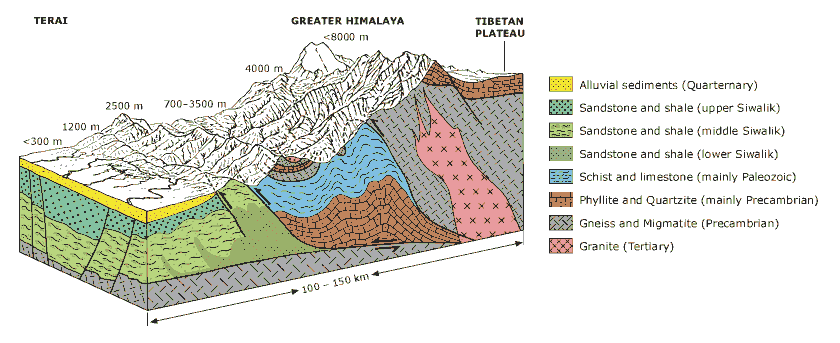|
| The Himalaya |
The Himalayas are even younger than the Alps. They also cover a much larger area than the Alps. Partly because of their youth, the Himalayas are the tallest mountain range on earth. The Himalayan front rises abruptly from the flat Ganges Plain. Not far from the front, Mount Everest, the tallest mountain on earth, towers to 8848 meters above sea level. Even the broad Tibetan plateau, which lies to the north of the Himalayan front, stands at an average elevation of about 5000 meters above sea level. The collision of the Indian craton with Eurasia resulted in the uplifting of the Himalayas. The high-standing Himalayan mountain system is maintained in approximate isostatic balance by a deep root. Thus, the Himalayan crust is extremely thick. Perhaps the most likely mechanism for this crustal thickening in the Himalayas is a doubling of the crust caused by the wedging of a large segment of the former Indian craton beneath Eurasia. A large fold-and-thrust belt parallels the northeastern margin of India, forming the main Himalayan mountain chain. When did the Indian craton arrive? Animal fossils provide some clues. When the Age of Mammals began, about 65 million years ago, India was an isolated island continent. The fossil record of the Indian peninsula indicates that the first Cenozoic mammals arrived about 45 million years ago. Mammals probably passed from Asia to the Indian craton when the northeastern corner of the craton collided with Indochina. The craton, however, did not make contact with Eurasia near its present position until about 15 million years ago. Indeed, much of the Himalayan uplift has occurred within the last 5 million years. The rate of the uplift is impressing, e.g. the region of Nanga Parbat has been uplifted by 10 kilometers in less than 10 million years. Also the Tibetan Plateau has been uplifted to an average elevation of more than 5000 m. At the summit of Mt. Everest are fossil-bearing limestones that were deposited beneath the sea around 510 million years ago. Remarkable is the fact that since India collided with Eurasia, the northward movement has not stopped, but India has moved about 2000 km further north. Hence, earthquakes still rumble through the Himalayan region as a result of movement along faults, and there is every reason to believe that mountain building here is far from over. |
1 - Collision of Eurasia and India |
2 - Overview of the structure of the Himalaya |
|
|

